Coca-Cola and UNICEF: Macro and Micro Environment Analysis Report
VerifiedAdded on 2019/12/17
|11
|2705
|600
Report
AI Summary
This report presents a comprehensive analysis of the business environments of Coca-Cola and UNICEF. It begins with an introduction defining the business environment and then proceeds to analyze the organizational structures of both companies, including their departments and interrelationships. The report then delves into the impact of macro-environmental factors, such as political, economic, social, technological, legal, and environmental factors (PESTLE analysis), on Coca-Cola, along with a SWOT analysis to identify strengths, weaknesses, opportunities, and threats. The analysis covers how these factors influence decision-making within the organizations, and concludes with reflective statements on the findings, highlighting the interplay between micro and macro environments. The report emphasizes the importance of understanding these factors for business success.
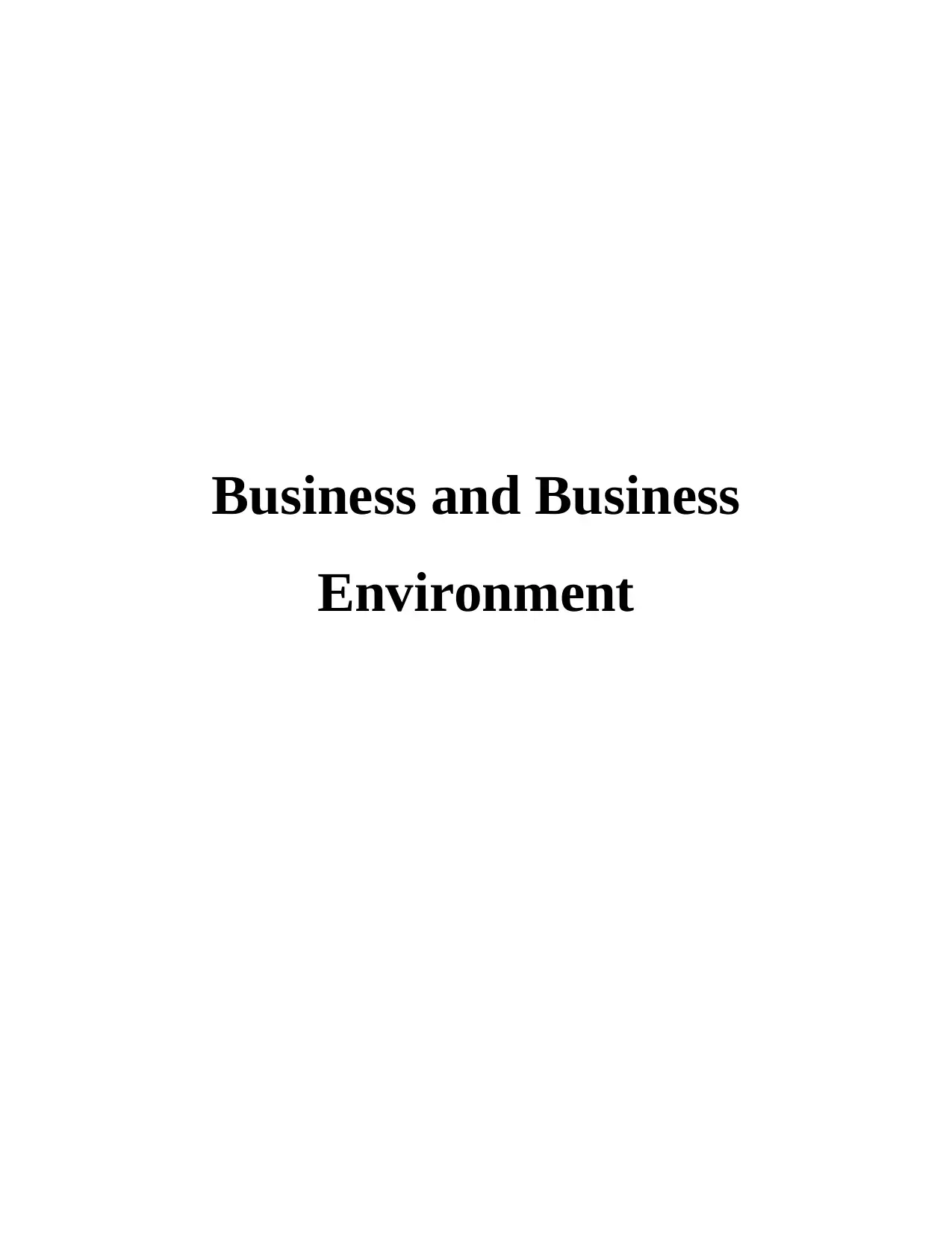
Business and Business
Environment
Environment
Paraphrase This Document
Need a fresh take? Get an instant paraphrase of this document with our AI Paraphraser
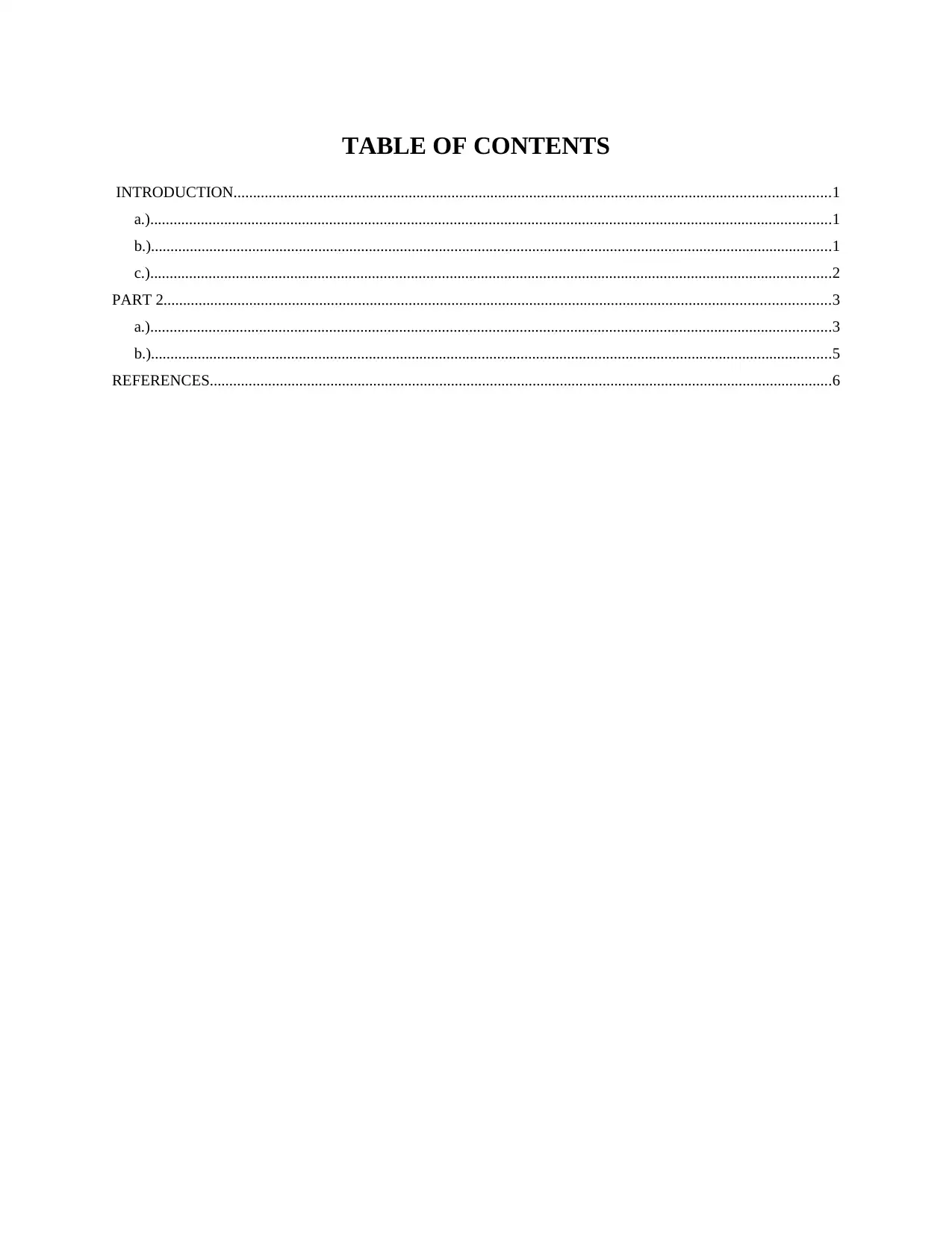
TABLE OF CONTENTS
INTRODUCTION.........................................................................................................................................................1
a.)...............................................................................................................................................................................1
b.)...............................................................................................................................................................................1
c.)...............................................................................................................................................................................2
PART 2...........................................................................................................................................................................3
a.)...............................................................................................................................................................................3
b.)...............................................................................................................................................................................5
REFERENCES................................................................................................................................................................6
INTRODUCTION.........................................................................................................................................................1
a.)...............................................................................................................................................................................1
b.)...............................................................................................................................................................................1
c.)...............................................................................................................................................................................2
PART 2...........................................................................................................................................................................3
a.)...............................................................................................................................................................................3
b.)...............................................................................................................................................................................5
REFERENCES................................................................................................................................................................6
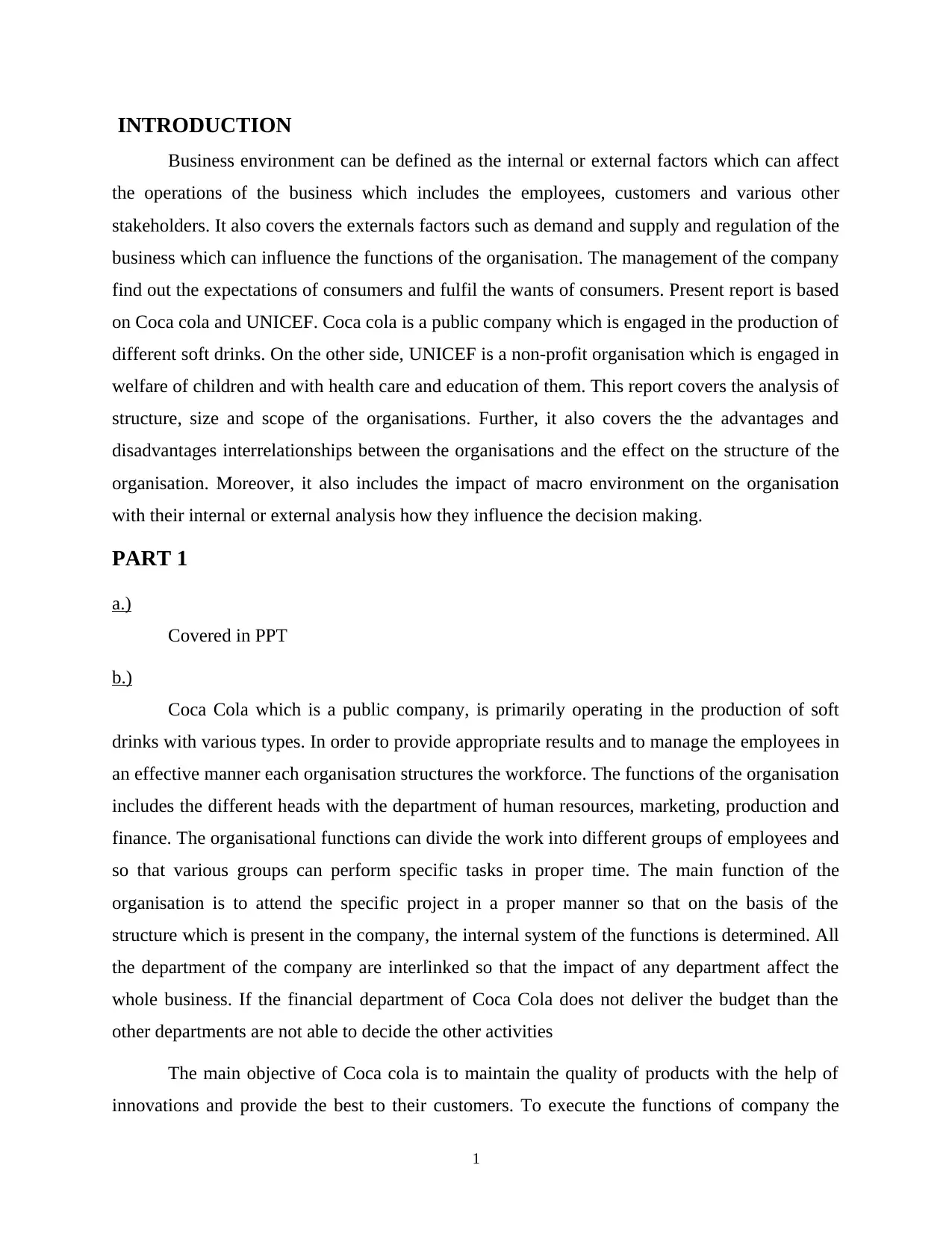
INTRODUCTION
Business environment can be defined as the internal or external factors which can affect
the operations of the business which includes the employees, customers and various other
stakeholders. It also covers the externals factors such as demand and supply and regulation of the
business which can influence the functions of the organisation. The management of the company
find out the expectations of consumers and fulfil the wants of consumers. Present report is based
on Coca cola and UNICEF. Coca cola is a public company which is engaged in the production of
different soft drinks. On the other side, UNICEF is a non-profit organisation which is engaged in
welfare of children and with health care and education of them. This report covers the analysis of
structure, size and scope of the organisations. Further, it also covers the the advantages and
disadvantages interrelationships between the organisations and the effect on the structure of the
organisation. Moreover, it also includes the impact of macro environment on the organisation
with their internal or external analysis how they influence the decision making.
PART 1
a.)
Covered in PPT
b.)
Coca Cola which is a public company, is primarily operating in the production of soft
drinks with various types. In order to provide appropriate results and to manage the employees in
an effective manner each organisation structures the workforce. The functions of the organisation
includes the different heads with the department of human resources, marketing, production and
finance. The organisational functions can divide the work into different groups of employees and
so that various groups can perform specific tasks in proper time. The main function of the
organisation is to attend the specific project in a proper manner so that on the basis of the
structure which is present in the company, the internal system of the functions is determined. All
the department of the company are interlinked so that the impact of any department affect the
whole business. If the financial department of Coca Cola does not deliver the budget than the
other departments are not able to decide the other activities
The main objective of Coca cola is to maintain the quality of products with the help of
innovations and provide the best to their customers. To execute the functions of company the
1
Business environment can be defined as the internal or external factors which can affect
the operations of the business which includes the employees, customers and various other
stakeholders. It also covers the externals factors such as demand and supply and regulation of the
business which can influence the functions of the organisation. The management of the company
find out the expectations of consumers and fulfil the wants of consumers. Present report is based
on Coca cola and UNICEF. Coca cola is a public company which is engaged in the production of
different soft drinks. On the other side, UNICEF is a non-profit organisation which is engaged in
welfare of children and with health care and education of them. This report covers the analysis of
structure, size and scope of the organisations. Further, it also covers the the advantages and
disadvantages interrelationships between the organisations and the effect on the structure of the
organisation. Moreover, it also includes the impact of macro environment on the organisation
with their internal or external analysis how they influence the decision making.
PART 1
a.)
Covered in PPT
b.)
Coca Cola which is a public company, is primarily operating in the production of soft
drinks with various types. In order to provide appropriate results and to manage the employees in
an effective manner each organisation structures the workforce. The functions of the organisation
includes the different heads with the department of human resources, marketing, production and
finance. The organisational functions can divide the work into different groups of employees and
so that various groups can perform specific tasks in proper time. The main function of the
organisation is to attend the specific project in a proper manner so that on the basis of the
structure which is present in the company, the internal system of the functions is determined. All
the department of the company are interlinked so that the impact of any department affect the
whole business. If the financial department of Coca Cola does not deliver the budget than the
other departments are not able to decide the other activities
The main objective of Coca cola is to maintain the quality of products with the help of
innovations and provide the best to their customers. To execute the functions of company the
1
⊘ This is a preview!⊘
Do you want full access?
Subscribe today to unlock all pages.

Trusted by 1+ million students worldwide
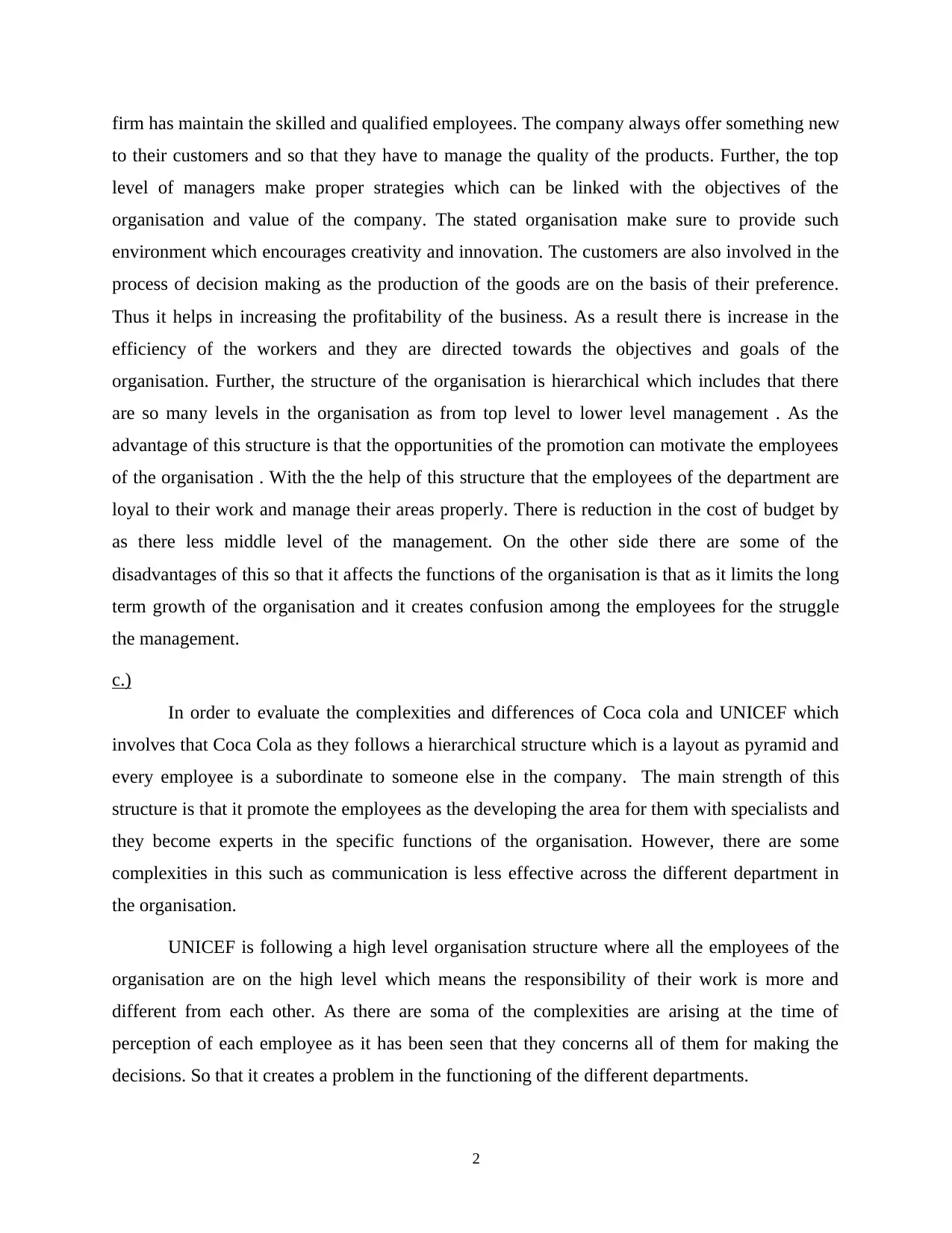
firm has maintain the skilled and qualified employees. The company always offer something new
to their customers and so that they have to manage the quality of the products. Further, the top
level of managers make proper strategies which can be linked with the objectives of the
organisation and value of the company. The stated organisation make sure to provide such
environment which encourages creativity and innovation. The customers are also involved in the
process of decision making as the production of the goods are on the basis of their preference.
Thus it helps in increasing the profitability of the business. As a result there is increase in the
efficiency of the workers and they are directed towards the objectives and goals of the
organisation. Further, the structure of the organisation is hierarchical which includes that there
are so many levels in the organisation as from top level to lower level management . As the
advantage of this structure is that the opportunities of the promotion can motivate the employees
of the organisation . With the the help of this structure that the employees of the department are
loyal to their work and manage their areas properly. There is reduction in the cost of budget by
as there less middle level of the management. On the other side there are some of the
disadvantages of this so that it affects the functions of the organisation is that as it limits the long
term growth of the organisation and it creates confusion among the employees for the struggle
the management.
c.)
In order to evaluate the complexities and differences of Coca cola and UNICEF which
involves that Coca Cola as they follows a hierarchical structure which is a layout as pyramid and
every employee is a subordinate to someone else in the company. The main strength of this
structure is that it promote the employees as the developing the area for them with specialists and
they become experts in the specific functions of the organisation. However, there are some
complexities in this such as communication is less effective across the different department in
the organisation.
UNICEF is following a high level organisation structure where all the employees of the
organisation are on the high level which means the responsibility of their work is more and
different from each other. As there are soma of the complexities are arising at the time of
perception of each employee as it has been seen that they concerns all of them for making the
decisions. So that it creates a problem in the functioning of the different departments.
2
to their customers and so that they have to manage the quality of the products. Further, the top
level of managers make proper strategies which can be linked with the objectives of the
organisation and value of the company. The stated organisation make sure to provide such
environment which encourages creativity and innovation. The customers are also involved in the
process of decision making as the production of the goods are on the basis of their preference.
Thus it helps in increasing the profitability of the business. As a result there is increase in the
efficiency of the workers and they are directed towards the objectives and goals of the
organisation. Further, the structure of the organisation is hierarchical which includes that there
are so many levels in the organisation as from top level to lower level management . As the
advantage of this structure is that the opportunities of the promotion can motivate the employees
of the organisation . With the the help of this structure that the employees of the department are
loyal to their work and manage their areas properly. There is reduction in the cost of budget by
as there less middle level of the management. On the other side there are some of the
disadvantages of this so that it affects the functions of the organisation is that as it limits the long
term growth of the organisation and it creates confusion among the employees for the struggle
the management.
c.)
In order to evaluate the complexities and differences of Coca cola and UNICEF which
involves that Coca Cola as they follows a hierarchical structure which is a layout as pyramid and
every employee is a subordinate to someone else in the company. The main strength of this
structure is that it promote the employees as the developing the area for them with specialists and
they become experts in the specific functions of the organisation. However, there are some
complexities in this such as communication is less effective across the different department in
the organisation.
UNICEF is following a high level organisation structure where all the employees of the
organisation are on the high level which means the responsibility of their work is more and
different from each other. As there are soma of the complexities are arising at the time of
perception of each employee as it has been seen that they concerns all of them for making the
decisions. So that it creates a problem in the functioning of the different departments.
2
Paraphrase This Document
Need a fresh take? Get an instant paraphrase of this document with our AI Paraphraser
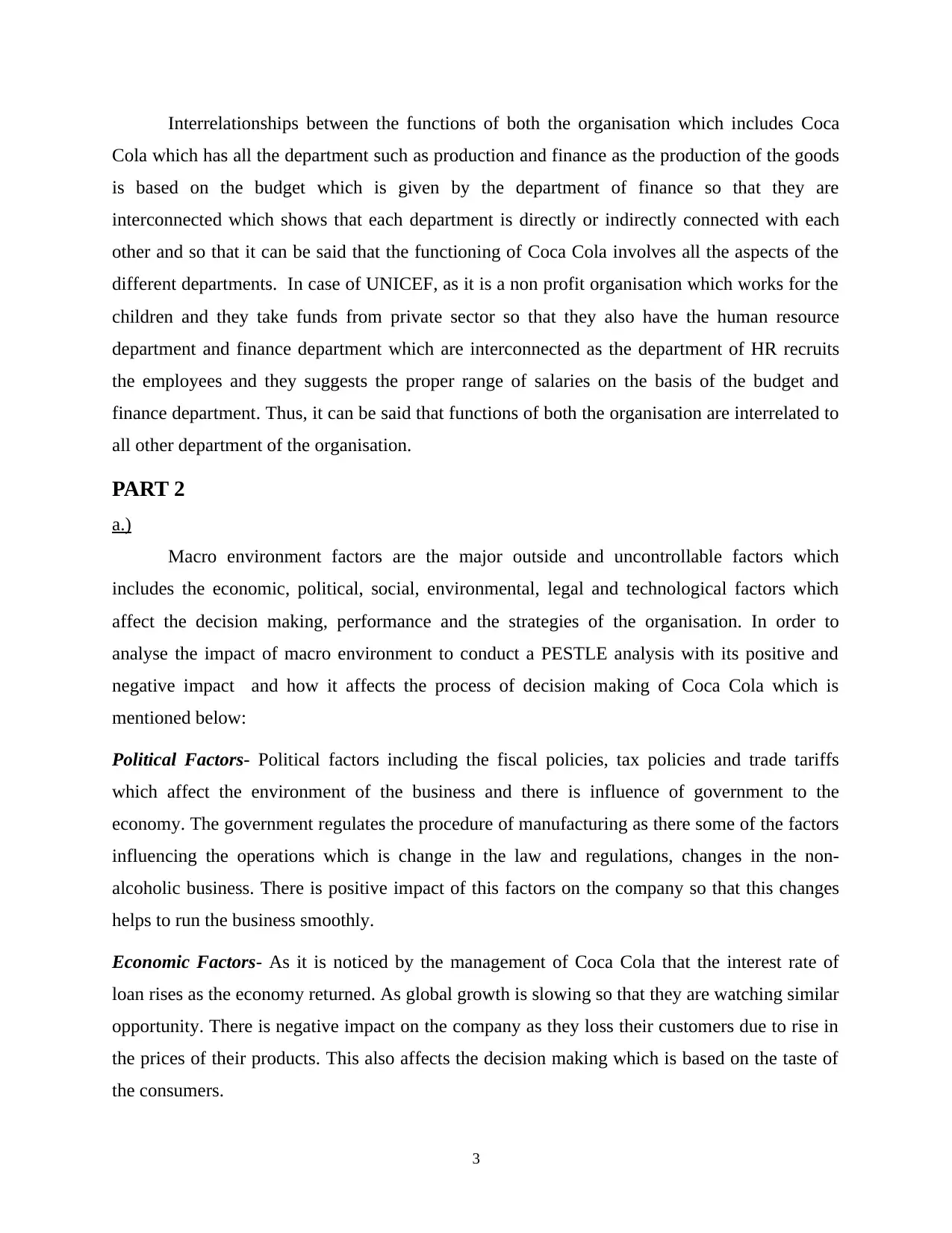
Interrelationships between the functions of both the organisation which includes Coca
Cola which has all the department such as production and finance as the production of the goods
is based on the budget which is given by the department of finance so that they are
interconnected which shows that each department is directly or indirectly connected with each
other and so that it can be said that the functioning of Coca Cola involves all the aspects of the
different departments. In case of UNICEF, as it is a non profit organisation which works for the
children and they take funds from private sector so that they also have the human resource
department and finance department which are interconnected as the department of HR recruits
the employees and they suggests the proper range of salaries on the basis of the budget and
finance department. Thus, it can be said that functions of both the organisation are interrelated to
all other department of the organisation.
PART 2
a.)
Macro environment factors are the major outside and uncontrollable factors which
includes the economic, political, social, environmental, legal and technological factors which
affect the decision making, performance and the strategies of the organisation. In order to
analyse the impact of macro environment to conduct a PESTLE analysis with its positive and
negative impact and how it affects the process of decision making of Coca Cola which is
mentioned below:
Political Factors- Political factors including the fiscal policies, tax policies and trade tariffs
which affect the environment of the business and there is influence of government to the
economy. The government regulates the procedure of manufacturing as there some of the factors
influencing the operations which is change in the law and regulations, changes in the non-
alcoholic business. There is positive impact of this factors on the company so that this changes
helps to run the business smoothly.
Economic Factors- As it is noticed by the management of Coca Cola that the interest rate of
loan rises as the economy returned. As global growth is slowing so that they are watching similar
opportunity. There is negative impact on the company as they loss their customers due to rise in
the prices of their products. This also affects the decision making which is based on the taste of
the consumers.
3
Cola which has all the department such as production and finance as the production of the goods
is based on the budget which is given by the department of finance so that they are
interconnected which shows that each department is directly or indirectly connected with each
other and so that it can be said that the functioning of Coca Cola involves all the aspects of the
different departments. In case of UNICEF, as it is a non profit organisation which works for the
children and they take funds from private sector so that they also have the human resource
department and finance department which are interconnected as the department of HR recruits
the employees and they suggests the proper range of salaries on the basis of the budget and
finance department. Thus, it can be said that functions of both the organisation are interrelated to
all other department of the organisation.
PART 2
a.)
Macro environment factors are the major outside and uncontrollable factors which
includes the economic, political, social, environmental, legal and technological factors which
affect the decision making, performance and the strategies of the organisation. In order to
analyse the impact of macro environment to conduct a PESTLE analysis with its positive and
negative impact and how it affects the process of decision making of Coca Cola which is
mentioned below:
Political Factors- Political factors including the fiscal policies, tax policies and trade tariffs
which affect the environment of the business and there is influence of government to the
economy. The government regulates the procedure of manufacturing as there some of the factors
influencing the operations which is change in the law and regulations, changes in the non-
alcoholic business. There is positive impact of this factors on the company so that this changes
helps to run the business smoothly.
Economic Factors- As it is noticed by the management of Coca Cola that the interest rate of
loan rises as the economy returned. As global growth is slowing so that they are watching similar
opportunity. There is negative impact on the company as they loss their customers due to rise in
the prices of their products. This also affects the decision making which is based on the taste of
the consumers.
3
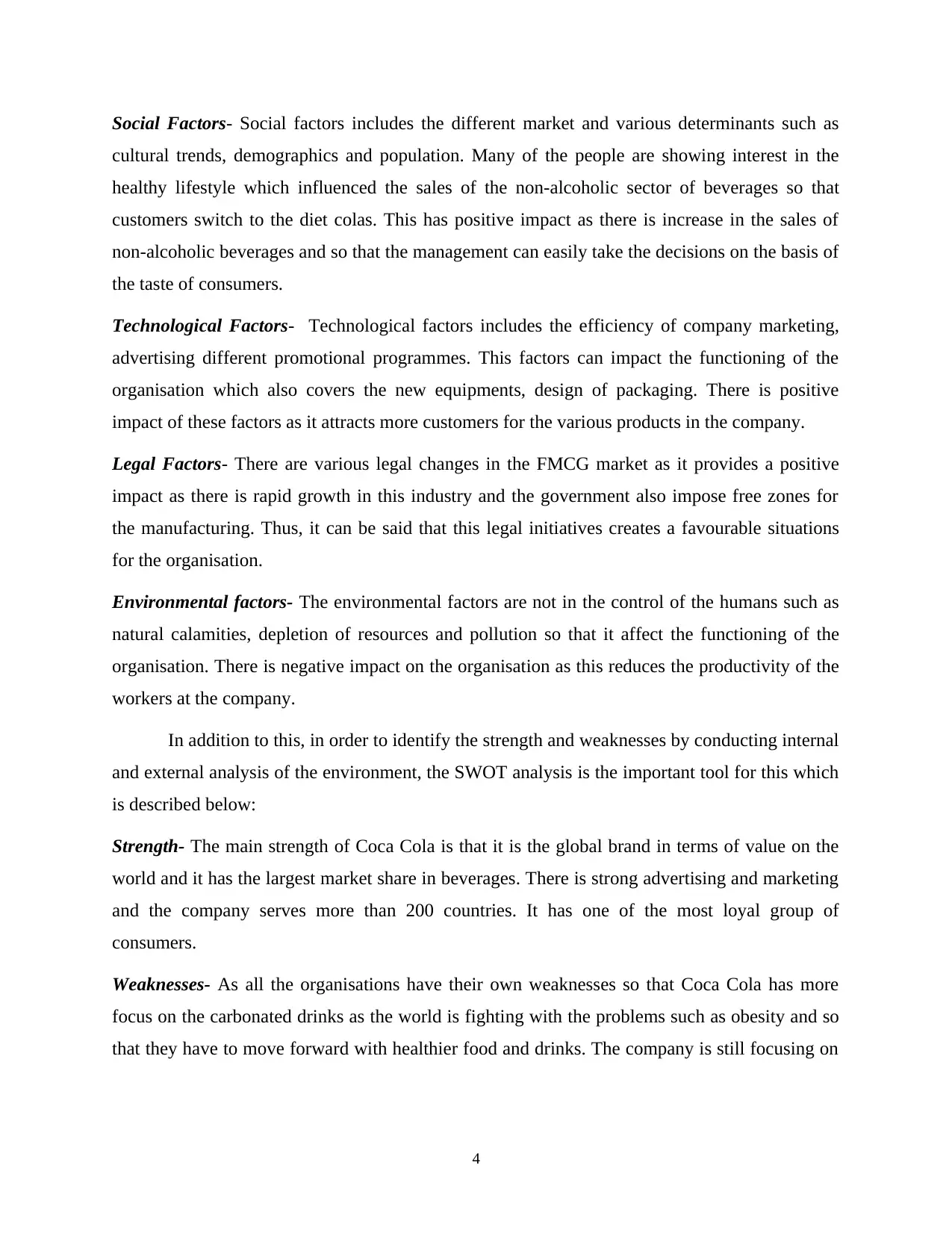
Social Factors- Social factors includes the different market and various determinants such as
cultural trends, demographics and population. Many of the people are showing interest in the
healthy lifestyle which influenced the sales of the non-alcoholic sector of beverages so that
customers switch to the diet colas. This has positive impact as there is increase in the sales of
non-alcoholic beverages and so that the management can easily take the decisions on the basis of
the taste of consumers.
Technological Factors- Technological factors includes the efficiency of company marketing,
advertising different promotional programmes. This factors can impact the functioning of the
organisation which also covers the new equipments, design of packaging. There is positive
impact of these factors as it attracts more customers for the various products in the company.
Legal Factors- There are various legal changes in the FMCG market as it provides a positive
impact as there is rapid growth in this industry and the government also impose free zones for
the manufacturing. Thus, it can be said that this legal initiatives creates a favourable situations
for the organisation.
Environmental factors- The environmental factors are not in the control of the humans such as
natural calamities, depletion of resources and pollution so that it affect the functioning of the
organisation. There is negative impact on the organisation as this reduces the productivity of the
workers at the company.
In addition to this, in order to identify the strength and weaknesses by conducting internal
and external analysis of the environment, the SWOT analysis is the important tool for this which
is described below:
Strength- The main strength of Coca Cola is that it is the global brand in terms of value on the
world and it has the largest market share in beverages. There is strong advertising and marketing
and the company serves more than 200 countries. It has one of the most loyal group of
consumers.
Weaknesses- As all the organisations have their own weaknesses so that Coca Cola has more
focus on the carbonated drinks as the world is fighting with the problems such as obesity and so
that they have to move forward with healthier food and drinks. The company is still focusing on
4
cultural trends, demographics and population. Many of the people are showing interest in the
healthy lifestyle which influenced the sales of the non-alcoholic sector of beverages so that
customers switch to the diet colas. This has positive impact as there is increase in the sales of
non-alcoholic beverages and so that the management can easily take the decisions on the basis of
the taste of consumers.
Technological Factors- Technological factors includes the efficiency of company marketing,
advertising different promotional programmes. This factors can impact the functioning of the
organisation which also covers the new equipments, design of packaging. There is positive
impact of these factors as it attracts more customers for the various products in the company.
Legal Factors- There are various legal changes in the FMCG market as it provides a positive
impact as there is rapid growth in this industry and the government also impose free zones for
the manufacturing. Thus, it can be said that this legal initiatives creates a favourable situations
for the organisation.
Environmental factors- The environmental factors are not in the control of the humans such as
natural calamities, depletion of resources and pollution so that it affect the functioning of the
organisation. There is negative impact on the organisation as this reduces the productivity of the
workers at the company.
In addition to this, in order to identify the strength and weaknesses by conducting internal
and external analysis of the environment, the SWOT analysis is the important tool for this which
is described below:
Strength- The main strength of Coca Cola is that it is the global brand in terms of value on the
world and it has the largest market share in beverages. There is strong advertising and marketing
and the company serves more than 200 countries. It has one of the most loyal group of
consumers.
Weaknesses- As all the organisations have their own weaknesses so that Coca Cola has more
focus on the carbonated drinks as the world is fighting with the problems such as obesity and so
that they have to move forward with healthier food and drinks. The company is still focusing on
4
⊘ This is a preview!⊘
Do you want full access?
Subscribe today to unlock all pages.

Trusted by 1+ million students worldwide
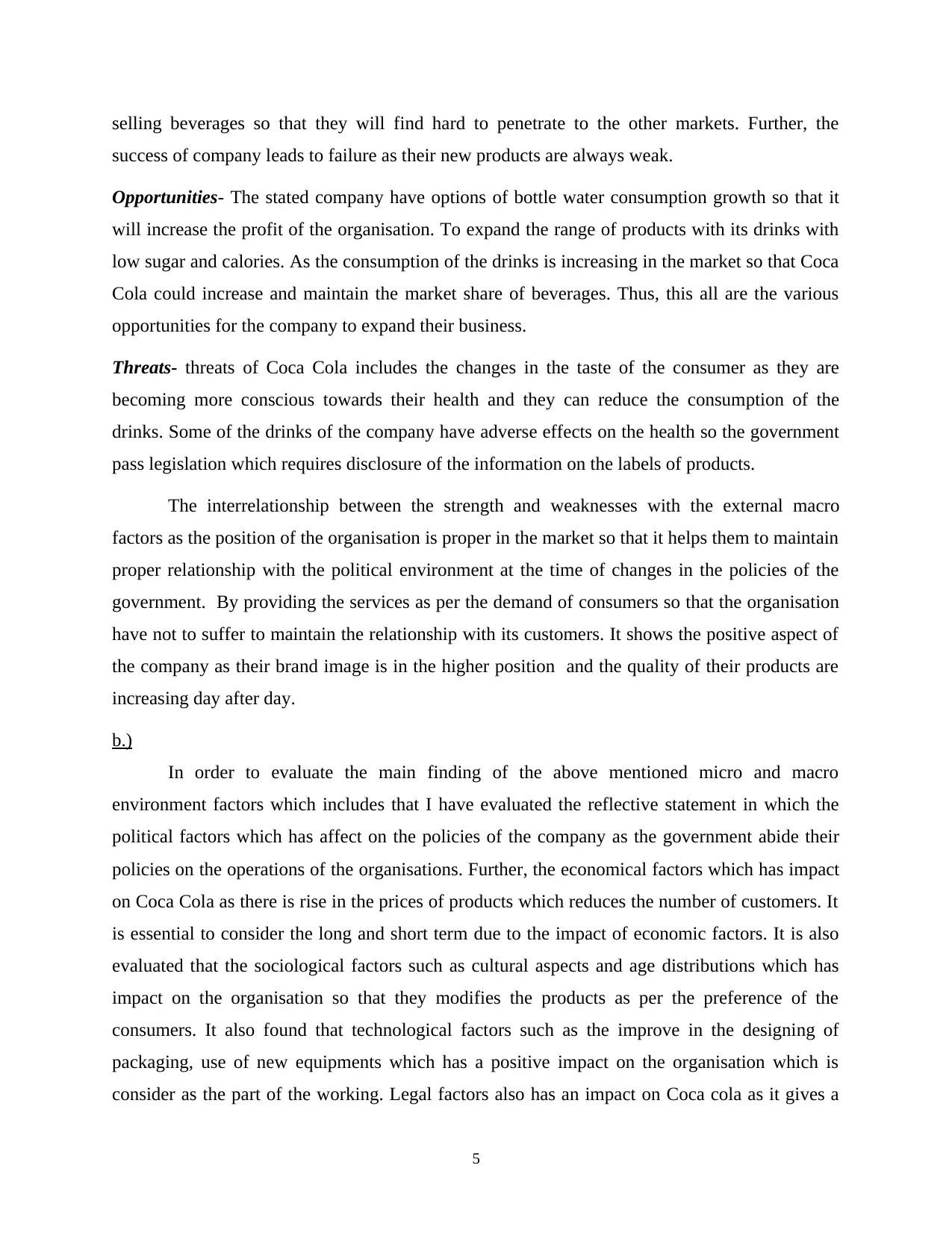
selling beverages so that they will find hard to penetrate to the other markets. Further, the
success of company leads to failure as their new products are always weak.
Opportunities- The stated company have options of bottle water consumption growth so that it
will increase the profit of the organisation. To expand the range of products with its drinks with
low sugar and calories. As the consumption of the drinks is increasing in the market so that Coca
Cola could increase and maintain the market share of beverages. Thus, this all are the various
opportunities for the company to expand their business.
Threats- threats of Coca Cola includes the changes in the taste of the consumer as they are
becoming more conscious towards their health and they can reduce the consumption of the
drinks. Some of the drinks of the company have adverse effects on the health so the government
pass legislation which requires disclosure of the information on the labels of products.
The interrelationship between the strength and weaknesses with the external macro
factors as the position of the organisation is proper in the market so that it helps them to maintain
proper relationship with the political environment at the time of changes in the policies of the
government. By providing the services as per the demand of consumers so that the organisation
have not to suffer to maintain the relationship with its customers. It shows the positive aspect of
the company as their brand image is in the higher position and the quality of their products are
increasing day after day.
b.)
In order to evaluate the main finding of the above mentioned micro and macro
environment factors which includes that I have evaluated the reflective statement in which the
political factors which has affect on the policies of the company as the government abide their
policies on the operations of the organisations. Further, the economical factors which has impact
on Coca Cola as there is rise in the prices of products which reduces the number of customers. It
is essential to consider the long and short term due to the impact of economic factors. It is also
evaluated that the sociological factors such as cultural aspects and age distributions which has
impact on the organisation so that they modifies the products as per the preference of the
consumers. It also found that technological factors such as the improve in the designing of
packaging, use of new equipments which has a positive impact on the organisation which is
consider as the part of the working. Legal factors also has an impact on Coca cola as it gives a
5
success of company leads to failure as their new products are always weak.
Opportunities- The stated company have options of bottle water consumption growth so that it
will increase the profit of the organisation. To expand the range of products with its drinks with
low sugar and calories. As the consumption of the drinks is increasing in the market so that Coca
Cola could increase and maintain the market share of beverages. Thus, this all are the various
opportunities for the company to expand their business.
Threats- threats of Coca Cola includes the changes in the taste of the consumer as they are
becoming more conscious towards their health and they can reduce the consumption of the
drinks. Some of the drinks of the company have adverse effects on the health so the government
pass legislation which requires disclosure of the information on the labels of products.
The interrelationship between the strength and weaknesses with the external macro
factors as the position of the organisation is proper in the market so that it helps them to maintain
proper relationship with the political environment at the time of changes in the policies of the
government. By providing the services as per the demand of consumers so that the organisation
have not to suffer to maintain the relationship with its customers. It shows the positive aspect of
the company as their brand image is in the higher position and the quality of their products are
increasing day after day.
b.)
In order to evaluate the main finding of the above mentioned micro and macro
environment factors which includes that I have evaluated the reflective statement in which the
political factors which has affect on the policies of the company as the government abide their
policies on the operations of the organisations. Further, the economical factors which has impact
on Coca Cola as there is rise in the prices of products which reduces the number of customers. It
is essential to consider the long and short term due to the impact of economic factors. It is also
evaluated that the sociological factors such as cultural aspects and age distributions which has
impact on the organisation so that they modifies the products as per the preference of the
consumers. It also found that technological factors such as the improve in the designing of
packaging, use of new equipments which has a positive impact on the organisation which is
consider as the part of the working. Legal factors also has an impact on Coca cola as it gives a
5
Paraphrase This Document
Need a fresh take? Get an instant paraphrase of this document with our AI Paraphraser
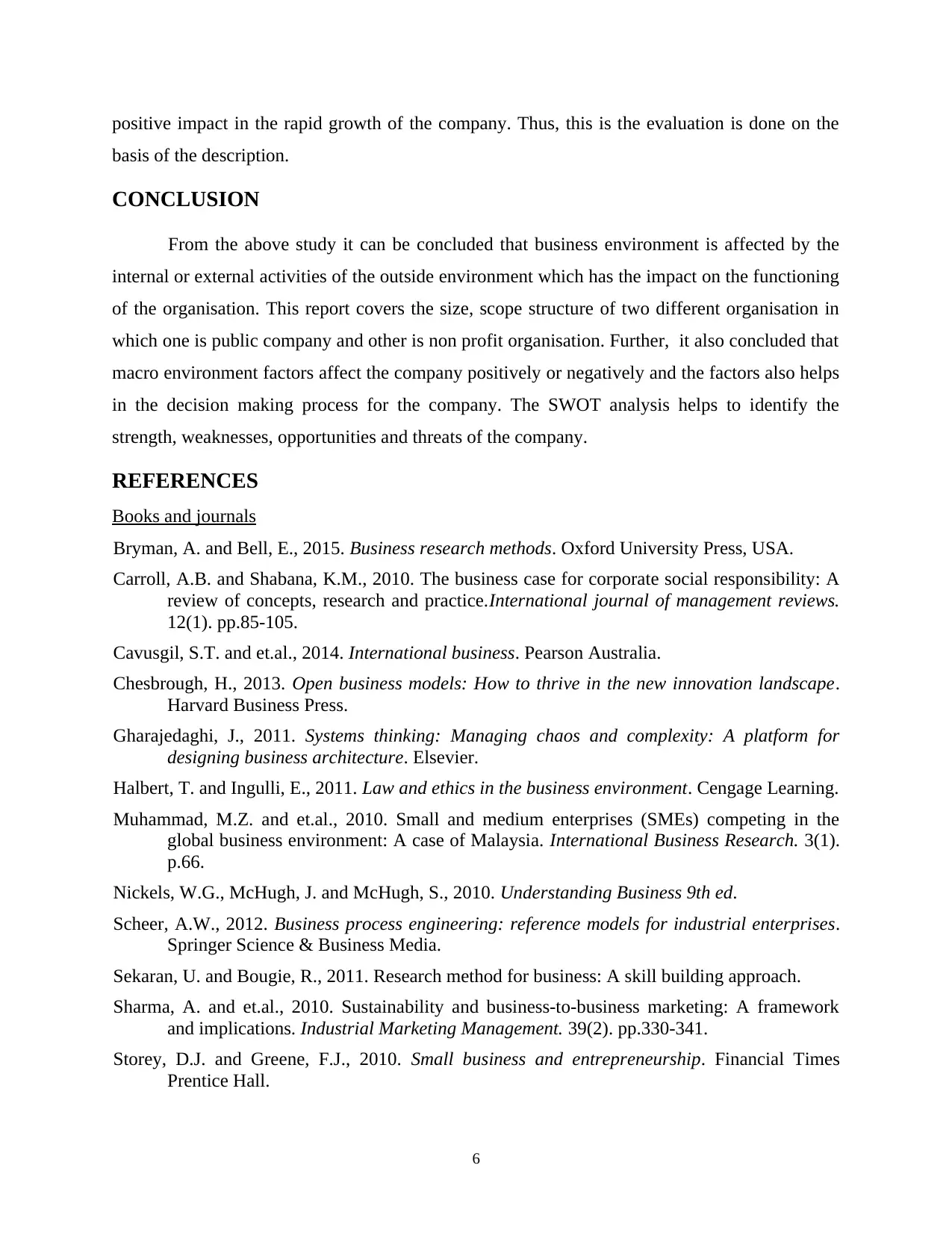
positive impact in the rapid growth of the company. Thus, this is the evaluation is done on the
basis of the description.
CONCLUSION
From the above study it can be concluded that business environment is affected by the
internal or external activities of the outside environment which has the impact on the functioning
of the organisation. This report covers the size, scope structure of two different organisation in
which one is public company and other is non profit organisation. Further, it also concluded that
macro environment factors affect the company positively or negatively and the factors also helps
in the decision making process for the company. The SWOT analysis helps to identify the
strength, weaknesses, opportunities and threats of the company.
REFERENCES
Books and journals
Bryman, A. and Bell, E., 2015. Business research methods. Oxford University Press, USA.
Carroll, A.B. and Shabana, K.M., 2010. The business case for corporate social responsibility: A
review of concepts, research and practice.International journal of management reviews.
12(1). pp.85-105.
Cavusgil, S.T. and et.al., 2014. International business. Pearson Australia.
Chesbrough, H., 2013. Open business models: How to thrive in the new innovation landscape.
Harvard Business Press.
Gharajedaghi, J., 2011. Systems thinking: Managing chaos and complexity: A platform for
designing business architecture. Elsevier.
Halbert, T. and Ingulli, E., 2011. Law and ethics in the business environment. Cengage Learning.
Muhammad, M.Z. and et.al., 2010. Small and medium enterprises (SMEs) competing in the
global business environment: A case of Malaysia. International Business Research. 3(1).
p.66.
Nickels, W.G., McHugh, J. and McHugh, S., 2010. Understanding Business 9th ed.
Scheer, A.W., 2012. Business process engineering: reference models for industrial enterprises.
Springer Science & Business Media.
Sekaran, U. and Bougie, R., 2011. Research method for business: A skill building approach.
Sharma, A. and et.al., 2010. Sustainability and business-to-business marketing: A framework
and implications. Industrial Marketing Management. 39(2). pp.330-341.
Storey, D.J. and Greene, F.J., 2010. Small business and entrepreneurship. Financial Times
Prentice Hall.
6
basis of the description.
CONCLUSION
From the above study it can be concluded that business environment is affected by the
internal or external activities of the outside environment which has the impact on the functioning
of the organisation. This report covers the size, scope structure of two different organisation in
which one is public company and other is non profit organisation. Further, it also concluded that
macro environment factors affect the company positively or negatively and the factors also helps
in the decision making process for the company. The SWOT analysis helps to identify the
strength, weaknesses, opportunities and threats of the company.
REFERENCES
Books and journals
Bryman, A. and Bell, E., 2015. Business research methods. Oxford University Press, USA.
Carroll, A.B. and Shabana, K.M., 2010. The business case for corporate social responsibility: A
review of concepts, research and practice.International journal of management reviews.
12(1). pp.85-105.
Cavusgil, S.T. and et.al., 2014. International business. Pearson Australia.
Chesbrough, H., 2013. Open business models: How to thrive in the new innovation landscape.
Harvard Business Press.
Gharajedaghi, J., 2011. Systems thinking: Managing chaos and complexity: A platform for
designing business architecture. Elsevier.
Halbert, T. and Ingulli, E., 2011. Law and ethics in the business environment. Cengage Learning.
Muhammad, M.Z. and et.al., 2010. Small and medium enterprises (SMEs) competing in the
global business environment: A case of Malaysia. International Business Research. 3(1).
p.66.
Nickels, W.G., McHugh, J. and McHugh, S., 2010. Understanding Business 9th ed.
Scheer, A.W., 2012. Business process engineering: reference models for industrial enterprises.
Springer Science & Business Media.
Sekaran, U. and Bougie, R., 2011. Research method for business: A skill building approach.
Sharma, A. and et.al., 2010. Sustainability and business-to-business marketing: A framework
and implications. Industrial Marketing Management. 39(2). pp.330-341.
Storey, D.J. and Greene, F.J., 2010. Small business and entrepreneurship. Financial Times
Prentice Hall.
6
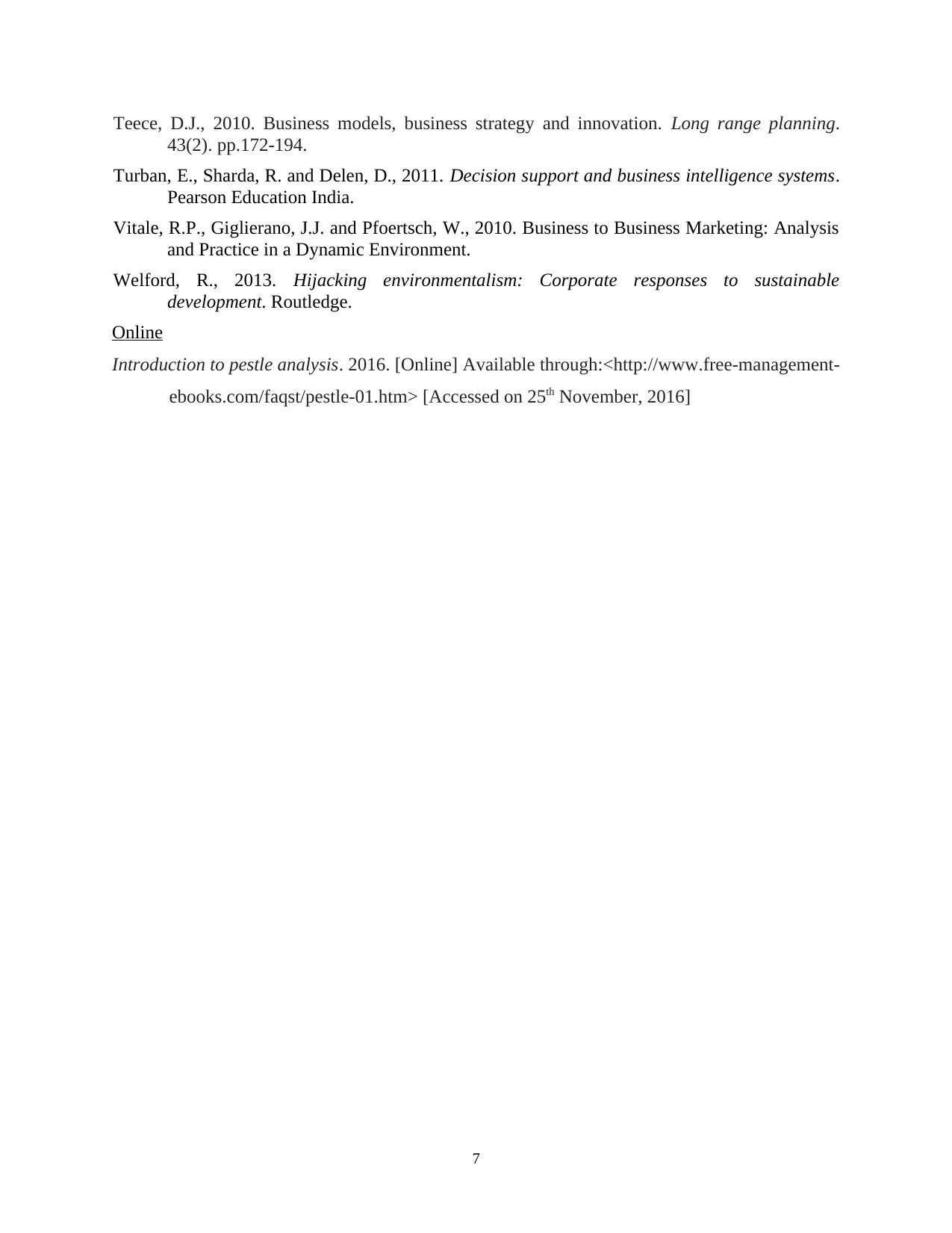
Teece, D.J., 2010. Business models, business strategy and innovation. Long range planning.
43(2). pp.172-194.
Turban, E., Sharda, R. and Delen, D., 2011. Decision support and business intelligence systems.
Pearson Education India.
Vitale, R.P., Giglierano, J.J. and Pfoertsch, W., 2010. Business to Business Marketing: Analysis
and Practice in a Dynamic Environment.
Welford, R., 2013. Hijacking environmentalism: Corporate responses to sustainable
development. Routledge.
Online
Introduction to pestle analysis. 2016. [Online] Available through:<http://www.free-management-
ebooks.com/faqst/pestle-01.htm> [Accessed on 25th November, 2016]
7
43(2). pp.172-194.
Turban, E., Sharda, R. and Delen, D., 2011. Decision support and business intelligence systems.
Pearson Education India.
Vitale, R.P., Giglierano, J.J. and Pfoertsch, W., 2010. Business to Business Marketing: Analysis
and Practice in a Dynamic Environment.
Welford, R., 2013. Hijacking environmentalism: Corporate responses to sustainable
development. Routledge.
Online
Introduction to pestle analysis. 2016. [Online] Available through:<http://www.free-management-
ebooks.com/faqst/pestle-01.htm> [Accessed on 25th November, 2016]
7
⊘ This is a preview!⊘
Do you want full access?
Subscribe today to unlock all pages.

Trusted by 1+ million students worldwide
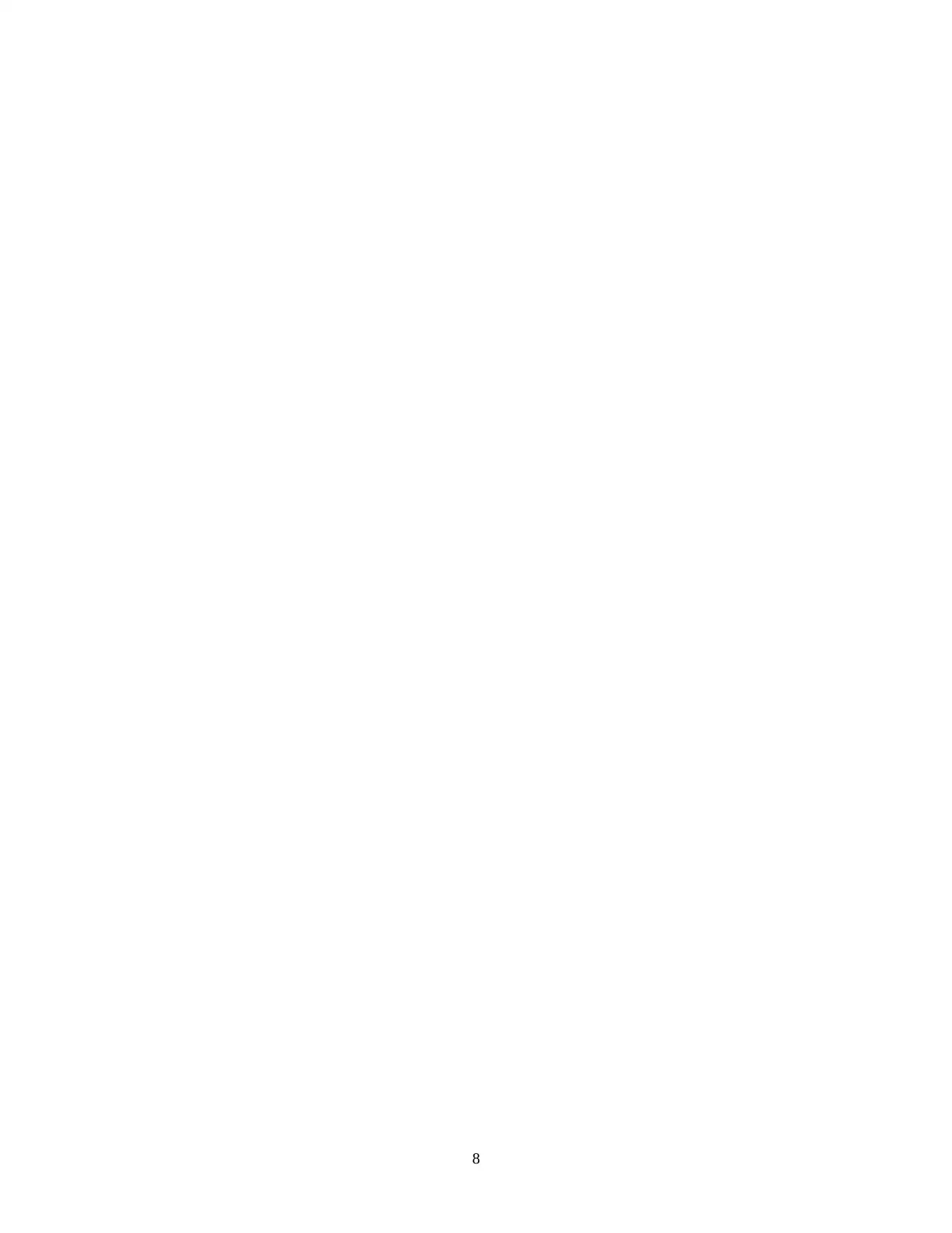
8
Paraphrase This Document
Need a fresh take? Get an instant paraphrase of this document with our AI Paraphraser
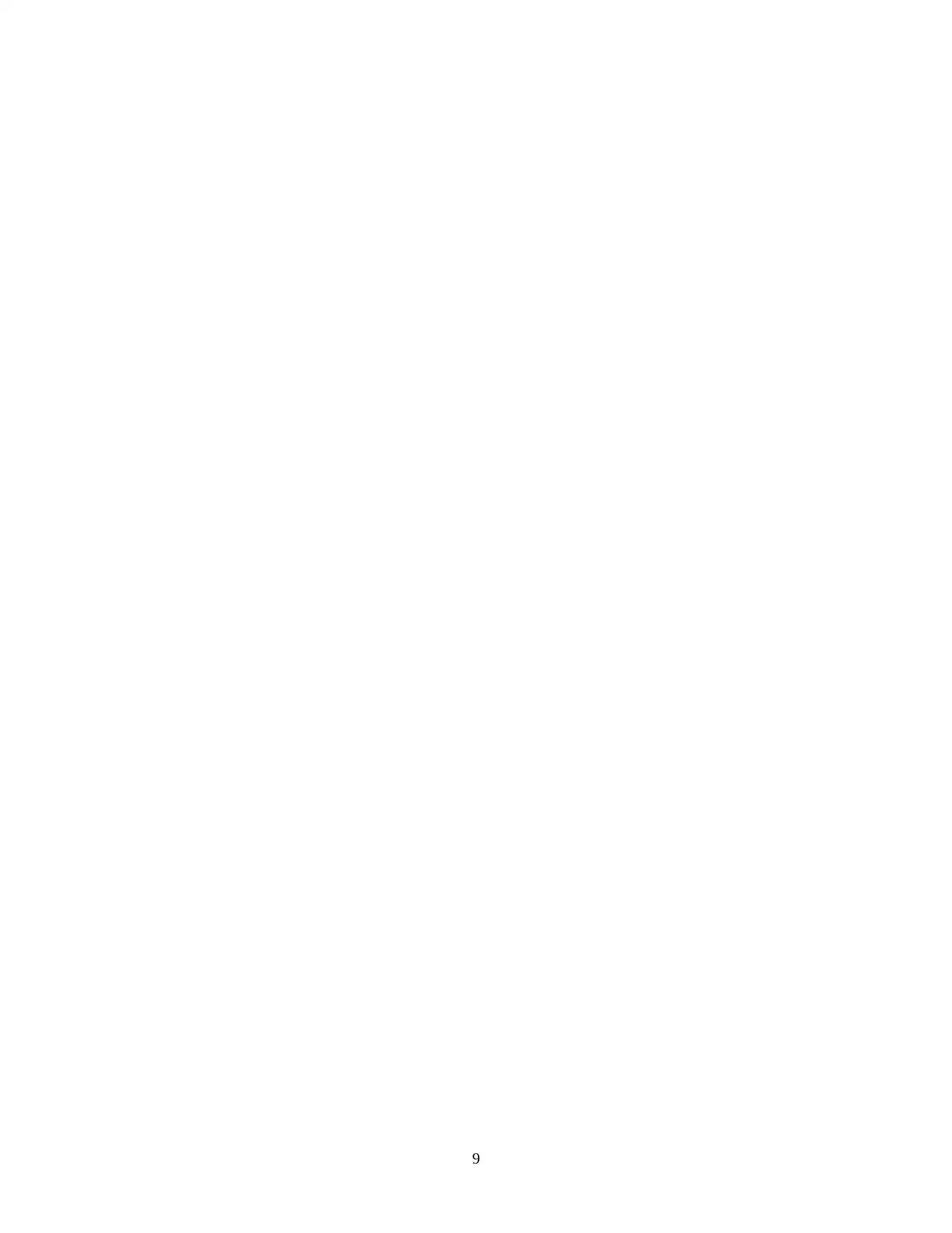
9
1 out of 11
Related Documents
Your All-in-One AI-Powered Toolkit for Academic Success.
+13062052269
info@desklib.com
Available 24*7 on WhatsApp / Email
![[object Object]](/_next/static/media/star-bottom.7253800d.svg)
Unlock your academic potential
Copyright © 2020–2025 A2Z Services. All Rights Reserved. Developed and managed by ZUCOL.




